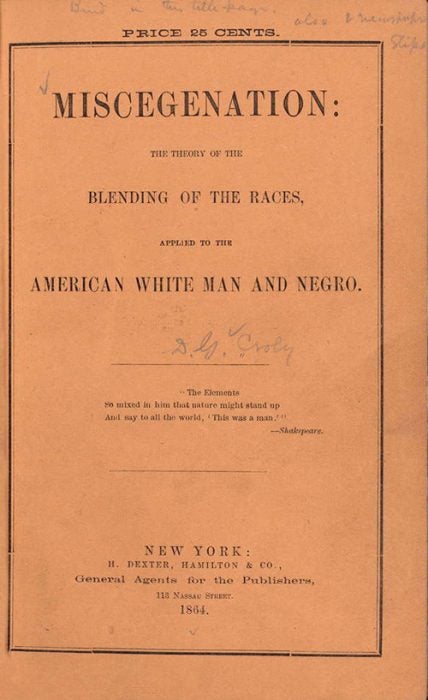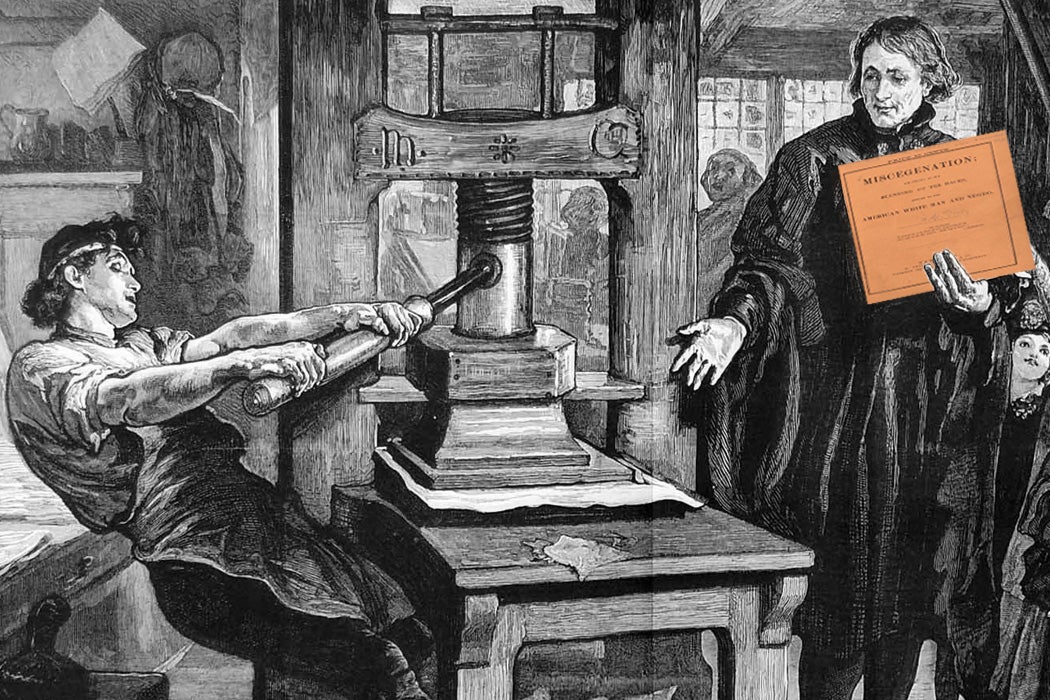In 1864, a pamphlet entitled “Miscegenation: The Theory of the Blending of the Races, Applied to the American White Man and Negro” began to circulate on the streets of New York. The title certainly would have given New Yorkers pause. No one had ever seen the word “miscegenation” before. In fact, the pamphlet’s anonymous author invented it, giving the reason that “amalgamation”—then the most common term used to describe “race mixing”—was a “poor word, since it properly refers to the union of metals with quicksilver.” The term “miscegenation”—from the Latin miscere (to mix) and genus (race)—had only one definition.
Besides introducing a new word into the English language, the pamphleteer was also responsible for what appeared to be one of the most fearless documents in the archive of nineteenth century abolitionist writing. Among many other claims and political recommendations, the pamphlet notes that, “the miscegenetic or mixed races are much superior, mentally, physically, and morally, to those pure or unmixed;” that “a continuance of progress can only be obtained through a judicious crossing of diverse elements;” that “the Caucasian, or white race… has never yet developed a religious faith on its own;” that “the true ideal man can only be reached by blending the type man and woman of all the races of the earth;” that “the most beautiful girl in form, feature, and every attribute of feminine loveliness [the pamphleteer] ever saw, was a mulatto.” Most provocatively, the writer claimed that “the Southern beauty… proclaims by every massive ornament in her shining hair, and by every yellow shade in the wavy folds of her dress, ‘I love the black man.’”
At the time, Miscegenation was radical. Even among the most radical abolitionists of the day, interracial marriage was tolerated, but rarely explicitly encouraged. (Massachusetts senator Charles Sumner and prominent abolitionist Wendell Phillips were exceptions.) Eurocentric racial hierarchies were often deeply ingrained in their thinking.
Throughout Miscegenation, the author is at pains to exalt Black Americans as exemplars of “the beau idéal of true manhood.” Though it is full of pseudoscience and faulty reasoning (lots of talk of skull measuring and the effect of temperature on skin color), its intentions seem noble. One wonders how the racial politics of the Reconstruction would have played out had more people thought like the pamphleteer.
Around Christmas of 1863, before Miscegenation’s official publication, the pamphleteer sent his work out to a host of prominent abolitionists, many of whom expressed, through letters sent to the publisher, an admiration, as the historian Sidney Kaplan writes in his definitive account, “tempered with cautious enthusiasm both for the substance of the pamphlet and for the timeliness of its publication.” While it generally met with encouragement, many of the pamphlet’s readers urged caution, seemingly worried that the nation might not be ready for such dramatic measures. They might have been especially concerned that the pamphlet not be aligned too closely with the push for Lincoln’s reelection, especially because it recommended that the Republican Party include miscegenation as a plank in its platform. Lincoln himself was sent a copy, but he did not respond.
In addition, nobody seems to have commented on the pamphlet’s inflammatory descriptions of Irish immigrants as “coarse-grained, revengeful, unintellectual” people with “very few of the finer instincts of humanity” who could benefit from “blending” with Blacks. Only six months earlier, working men, including many Irish immigrants, had rioted in New York, angry at the new institution of the draft and the prospect of competition from newly emancipated former slaves. The rioters attacked Black people, their homes, and their businesses, killing more than 100 people and causing millions of dollars of property damage.

Nevertheless, the pamphleteer pressed on. He aggressively promoted his work. As Kaplan tells us, by February 1864, Miscegenation “was being advertised provocatively in the principal Abolitionist papers of the country as available for purchase at newsstands or at the publisher’s office.” Soon after, it garnered glowing reviews in anti-slavery publications and sneering reviews in pro-slavery publications. Horace Greeley’s anti-slavery Tribune was accused of “advocating miscegenation,” doggerel verse was written on the theme, and the entire affair boiled over into a full-blown controversy, with pro-slavery advocates claiming that Lincoln sought to force Whites to marry Blacks. Anti-slavery advocates disavowed the claim.
Pamphlets were published in response with titles like “What Miscegenation is! And What We Are to Expect Now that Lincoln Is Reelected” and “Subgenation: The Theory of the Normal Relation of the Races; An Answer to ‘Miscegenation.’” The pamphlet “Miscegenation or Amalgamation: Fate of the Freedman” consisted of a speech delivered to the House of Representatives in 1864 by Ohio congressman Samuel S. Cox in which he argued against the establishment of the Freedmen’s Bureau and against the idea that a free Black population could survive without slavery to perpetuate it. Cox proclaimed that “I do not believe that the doctrine of miscegenation, or the amalgamation of the white and the black, now strenuously urged by the abolition leaders, will save the negro.”
While most of the pamphlet’s readers seemed to take Miscegenation’s science at face value, later in 1864 an anonymous reviewer for the Anthropological Review (published in England) wrote: “We should not have thought it worth while to take any notice of the publication of the pamphlet under review, if it did not give us some insight in the extraordinary mental aberration now going on in Yankeedom.” The reviewer maintains a tone of scathing sarcasm throughout, finding the document full of “willful misrepresentation” of scientific data, “misuse” of monogenist theory, and generally full of anthropological falsehoods. In fact, the reviewer found the opinions of the pamphleteer so outlandish that initially “we expected it was merely a hoax.”
As it turns out, the reviewer’s suspicion was well-founded. Miscegenation actually had two authors, David Goodman Croly and George Wakeman. And far from radical abolitionists, they were both in the employ of the New York World newspaper, a partisan Democratic organ staunchly opposed to the abolitionist cause, to say nothing of interracial marriage. The Miscegenation pamphlet and the word “miscegenation” itself were acts of trolling on a grand scale.
The mudslinging continued, and on March 24, the World, published an anonymous editorial, written by Croly himself, that took aim at the pamphlet:
A writer who seriously advocates the intermarriage and cohabitation of white men with negresses, and white women with negroes, has little claim to notice, on his own account, by journals which make it their chief business to mark and interpret the current indications of public sentiment.
But, the editorial suggests, if such a writer promotes an opinion anonymously, it may be because it expresses some idea already possessed by the public, and in fact, public endorsement “or the opposition it excites… makes it an index of public sentiment.” Given that Miscegenation was already the object of quite a bit of both endorsement and opposition, the editorial writer basically says that the anonymity of the author is reason enough to suppose that the pamphlet represents beliefs already actively held or opposed by the public.
Further, given that the pamphlet’s ideas had been repeated by “the leading negrophilists of the country,” it made sense to suppose that the miscegenist agenda was a central tenet of abolitionism in general, that its ideas were already commonly held. From the perspective of the reading public, it might well have appeared that the miscegenation issue was a part of the abolitionist zeitgeist or that compulsory intermarriage was in some way a logical extension of the anti-slavery position. Just as the more paranoid anti-abolitionists had suspected all along, Miscegenation “confirmed” that race mixing was not only a consequence of abolition, but its true and secret goal.
While the hoax effectively ended after the 1864 presidential campaign, nobody unmasked Croly and Wakeman. As Kaplan tells us, decades later, some still thought Miscegenation was a genuine abolitionist document, while many in Washington immediately recognized it as a satire or “burlesque.” Despite its essentially fictional status, Miscegenation brought to the surface the idea that race is a substantive and measurable quality, that race is expressed in visible bodily differences that index internal differences (whether they be biological, cognitive, emotional, or temperamental). These ideas sustain the belief that race mixing, if it proceeds unchecked, will lead to the disappearance of the differences between the races.
Once a Week
In essence, the Miscegenation hoax was an extremely well-crafted bid to “control the narrative.” Croly and Wakeman, acting on behalf of Northern anti-Black political interests, managed to centralize miscegenation discourse, using it to rile up anti-abolitionists. They did not manage to achieve their primary aim, which was to defeat Lincoln in the 1864 election. But they achieved much besides that. They invented and put into circulation a new word to replace the quasi-euphemistic “amalgamation,” one that lent an air of scientific objectivity to what was, in reality, a thoroughly political affair. They snuck ideas that were unpalatably radical into abolitionist discourse in a way that could be neither fully affirmed nor disavowed. They invented the very political liabilities that they and their political fellow-travelers would then exploit. Far from making interracial relationships more acceptable, the term “miscegenation,” as the literary scholar Elise Lemire points out, “did the work of enforcing the prohibition against certain marriages.”
The problem of “miscegenation” has never quite shaken the highly contradictory, borderline nonsensical political positions that first brought it into public discourse. There is a sense in which to speak of miscegenation or any other of its euphemisms is to play into the hands of Croly, Wakeman, and their ilk. The fact that people still speak of “mixed backgrounds” in everyday conversation indicates that we have not abandoned the basic conceptualizations of race that enabled the Miscegenation hoax in the first place: Before one can speak of “mixed races,” one must believe the races are separate enough that the idea of mixing them together makes intuitive sense. And, as the historian David Hollinger writes, though the word has mostly fallen out of use, many still regard “miscegenation” as “an ostensibly neutral word.” Similarly, the methods Croly and Wakeman used to insert “miscegenation” into the English language remain with us, as the trolling tactics they used to such powerful effect are once again involved in our elections.







